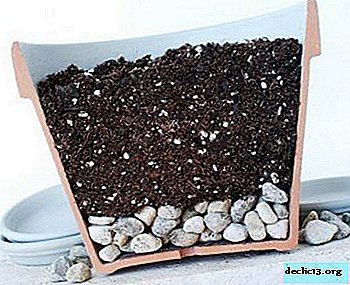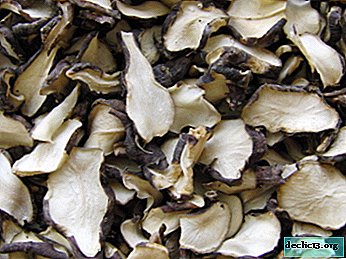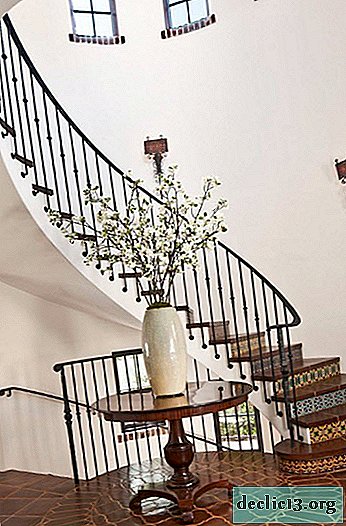All about red spathiphyllum: appearance, varieties and step-by-step instructions for caring for a plant

Spathiphyllum red - an invention - the acquisition of the latest generation of gardeners - an elegant and vibrant home flower.
A wonderful decoration of the living corner of every housewife, he brings a ray of brightness to home comfort.
What is the secret of this flower, which is also called “female happiness”, and also why it has a red color and how to care for it?
General Provisions
Definition
Quite often in shops and nurseries you can find red and pink spathiphyllums, which attract the attention of many lovers of exotic flowers. In fact spathiphyllum red - a modern invention of breeders. Among natural and hybrid varieties of this type does not exist.
The red color of the spathiphyllum flower veil is the result of chemical staining with special paints of an ordinary indoor flower. The paint is artificially introduced into the peduncle of spathiphyllum. In nature, flowers can only be white or mottled - greenish. Such commercial inventions are quite common in the modern flower industry.
Spathiphyllum red belongs to the Aroid family. Homeland is considered South and Central America, the Philippines, Mexico, Brazil. In natural conditions, spathiphyllum grows on the banks of rivers, lakes, and in tropical rain forests. Natural varieties grow in Central and South America, in New Guinea and in the Philippines. Habitat - swamp forests, sea coasts, river valleys and lakes.
Description of appearance
Spathiphyllum red is a perennial evergreen. The height of the adult flower is 40 - 50 cm. The leaves are dark green, narrow, oblong, slightly wavy. The structure of the leaves is leathery or glossy, pointed at the top. Basal rosette - a bunch is formed from basal leaves, the stem, as such, is absent.
Petioles are long, forked to half. Flower - a long sail, pointed at the end, curved. The cover of the flower is large, wraps the inflorescence - an ear of pale yellow or cream color. May bloom 2 times. The first time blooms in May, the duration of flowering is 3-4 weeks.. Repeated flowering in autumn or winter. Seeds are smooth, small.
Varieties
Red antarium is often mistaken for or given out as a spathiphyllum; many flower growers consider it a kind of hybrid spathiphyllum. Homeland is considered tropical South America. Antarium belongs to the Aroid family, has the name Male happiness. The leaves are large, bright green, have the shape of a heart. The peculiarity of this flower is that the leaves grow from the stem. The inflorescence is a rather large ear, located on the very cover of the flower. In literal translation, the name means flower - tail.
Photo
In the photo you can see what a female flower called spathiphyllum looks like.



Breeding History
Spathiphyllum was discovered hundreds of years ago, in the middle of the 19th century. Scientist Wallis traveling in South America. The first selection experiments were carried out in the 60 - 70s of the 20th century. To date, a large number of hybrid varietiesmore adapted to housing conditions.
Similarity with other colors
Male happiness or antarium is a decorative flower that is very similar to spathiphyllum with red flowers. The bloom of antarium is identical with the structure of the spathiphyllum flower - the same spacious blanket is a leaf, wraps an inflorescence. Only, unlike spathiphyllum, the antarium blooms in a saturated - bright color.
Step-by-step instruction
Home Care
- The pot can be matched from any material. You can use concrete tubes, including those made by yourself.
Tip! At each transplant, the pot or other container should be only 1 - 2 cm larger than the previous planting pot. Spathiphyllum red does not like too large pots.
- This variety does not tolerate direct sunlight. Lighting should be bright, but not strong. In winter, they connect artificial lamps. And in the summer, if the pots are installed on the south side, additional shading of the windows is required.
It is important to avoid places with direct cold air from an air conditioner or fan. Spathiphyllum red is afraid of drafts.
- Watering, moderate in autumn and winter, but intensified in summer, especially in the heat. Air temperature should not exceed 30 -32 ° С. Spraying, wiping the leaves with a damp sponge will reduce the temperature of the flower by 3-4 ° C. The flower is thermophilic, the optimum temperature for normal growth and development is 18 - 22 ° C. Strong temperature drops can trigger diseases, spathiphyllum red can stop flowering.
After watering, the water in the pan should not stagnate, this can provoke rot of the roots and leaves.
- This tropical flower does not require special pruning. When transplanting, it is desirable to cut the lateral processes to maintain the size of the leaves and good flowering. Also, after flowering of red spathiphyllum, it is recommended to cut the peduncle to the very base, so a new bud will soon form.
- Spathiphyllum red needs loose, slightly acidic soil. Wet, heavy soils are fatal to him.
 You can prepare the soil mixture yourself:
You can prepare the soil mixture yourself:- 2 t. Turf and leaf land;
- 1 tsp. Sour peat, coarse sand;
- some crushed charcoal;
- brick chips;
- 2 - 3 granules of mineral fertilizers;
- pieces of pine bark.
The drainage base performs a breathable function, does not allow stagnation of water.
It is better for beginning gardeners to purchase a substrate in the store, for this variety a universal mixture for aroid or tropical flowers is suitable.
Top dressing
Spathiphyllum red requires special attention to fertilizer and additional nutrition. The flower is fertilized in spring with mineral fertilizers - 1 - 2 g per 1 liter of water. Young flowers are fed 1 time in 2 to 3 weeks. Doses should be weak. It is enough to fertilize an adult flower once a month. In winter, at rest, the amount of fertilizer is reduced.
Attention! Liquid fertilizers are used when spraying - this perfectly complements the root dressing.Nitrogen fertilizers are useful for building greenery in the bush. For the density and brightness of flowering, potash - phosphorus fertilizers in a ratio of 1: 1 are preferred. You can fertilize the soil with organic fertilizers - diluted bird droppings, etc.
Transfer
Spatiphyllum red transplant is usually performed after flowering., after 2 to 3 weeks. A young flower is transplanted every year 3-4 times.
The safest and most reliable way of transplantation is the transshipment method.
Transplant procedure:
- At the bottom laid out a drainage layer of 2 cm.
- The flower is carefully removed along with the previously soaked earthen lump.
- The bush is transplanted into a new pot, the voids are filled with a specially prepared mixture.
- Tamped with a spatula, watered abundantly.
- For 2 to 3 days, watering is stopped, it is enough to spray the leaves.
Breeding
 In the greenhouses spathiphyllum can be propagated by seeding. Any procedure for reproduction is carried out in the spring. For hybrid spathiphyllum red, a method of reproduction by dividing the bush is more suitable:
In the greenhouses spathiphyllum can be propagated by seeding. Any procedure for reproduction is carried out in the spring. For hybrid spathiphyllum red, a method of reproduction by dividing the bush is more suitable:
- The substrate is well soaked.
- The flower is removed.
- The roots are cleaned from dry and infected fragments.
- Sliced areas are dusted with charcoal.
- The division of the bush is carried out directly - the processes are separated.
- Each part of the new seedling should have 2 to 3 rosettes and a healthy part of the root.
- At the bottom laid out drainage.
- The sapling falls, is covered with a substrate, slightly tamped.
- Watering required.
Pests and diseases
To avoid diseases, it is necessary to observe flower hygiene - regularly treated with water at room temperature.
The leaves turned yellow around the edges in winter - a signal that the red spathiphyllum is lacking in light. Or, on the contrary, there were burns from an overabundance of direct rays - you need to change the location of the pots.
Among the most common pests, aphids and scale insects are found. Washing the leaves with soapy water will help. The spider mite will help get rid of leaf treatment with a soapy solution with the addition of nicotine - sulfate.
For any treatment against diseases and pests, you need to cover the soil in the pot with a filmLeave the treated leaves for 12 hours and then rinse off with a shower. The treatment is repeated 2 to 3 times.
Red spathiphyllum is an invention of the artist - a grower, the invention of an interactive age of selection. Its peculiarity is that they serve not only as decoration and complement to the interior, but also serve as an air purifier from benzene vapors and other harmful compounds.

 You can prepare the soil mixture yourself:
You can prepare the soil mixture yourself:















